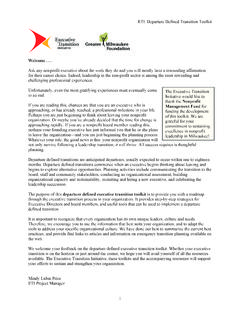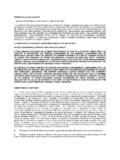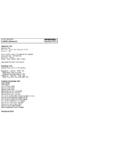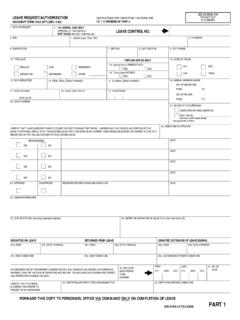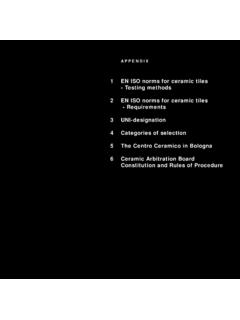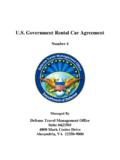Transcription of A guide to the Measurement of Roundness - Tarkkuustuonti
1 A guide to the Measurement of Roundness 1 Controlling Roundness improves performanceFrom power stations to power tools, from the smallestwatch to the largest car, all contain round any manufacturing facility it will be seen that machinesare producing round or cylindrical components. It is afunction of engineering to determine and specify howround they must be; it is a function of metrology to verifyif the specification has been contributes to function and performance inmany ways, not least of which is maintaining a lubricatingfilm between mating components. Although Roundness and size both play a significant rolein the way things fit together, Roundness is evaluatedindependent of size and must therefore be measuredin a different to roundnessDiameter is not the same as roundnessMany people incorrectly believe that it is sufficient tomeasure the diameter of a workpiece in several places,with the difference in readings assumed to representOut-of- Roundness of the is very easy to dispel that theory by measuring thediameter of a British fifty pence coin.
2 The diameterreading of the coin is identical regardless of orientationyet the coin is very clearly not round!Why Roundness is importantIt has been said that the greatest benefits to mankind were derived firstly from the inventionof the alphabet and secondly from the invention of the wheel. Look around and consider howmuch your life depends on machines with rotating datum methodThe component is rotated on a highly accurate spindlewhich provides a circular datum. The workpiece axisis aligned with the axis of the spindle by means of acentering and leveling table. During rotation, a transducer measures radial variationsof the component with respect to the spindle adequate precison of the spindle and gauge head,the rotational datum method can be used for the mostextreme Roundness specifications and is suitable forboth internal and external Roundness Roundness is measuredGauge head(transducer)Rotating spindleVee-block (3 point) methodAs with the component manufacturing process, it isthe level of precision required that will determine themeasuring method and equipment to be cases where Roundness is not very critical, a simpletechnique is to place the part in a vee-block and rotateit in contact with a dial gauge.
3 If the part is perfectlyround the pointer of the gauge will not move. As is apparent in this diagram, the 3 point method isgreatly influenced by the spacing and phase of profileirregularities as well as the angle of the vee. Thus the results obtained may not accurately reflecthow the component will function nor will they provideinformation useful for correction of the machine toolthat produced the component. Definition of roundnessA component is described as round if all points of a cross section are equidistant to a commoncenter. Therefore, to measure Roundness , rotation of the component is necessary coupled withthe ability to measure change in radius. 3A picture of the results is not enoughIt is convenient to represent the radial variations outputfrom the gauge as a polar profile or graph.
4 Roundnessdeviation can be determined by placing a template overthe graph and visually centralizing the profile. Then thehighest peak and deepest valley are identified and thedistance between the two is measured. This method isdependent on operator skill and is prone to errors. Putting a number to itModern instruments Put a number to it! First we replace the old template with a computer generated perfect circle . Since this circleis derived from the actual measured data it is possible to mathematically calculate departureof the measured profile from its reference circle. In this way we can numerically and reliablydescribe an Out-of-Round condition. RONt, RONp and RONvParameter RONt ( Roundness total) is the most commonly used parameter. It is the maximumdeviation inside and outside the reference circle, and is the sum of RONp ( Roundness Peak) andRONv ( Roundness Valley) which are companion Roundness parameters are based on deviations from reference circles and the results willvary depending on the reference circle chosen.
5 Refer to pages 5 - 6 for additional discussion onreference circles and their effect on parameter and their effectsRoundness measurements always contain imperfections at a number of different upr as shownin the examples below. Filters are used to isolate frequencies or ranges of upr to enabledetailed examination of individual effects of machining defects and component function. Filters can be arranged to remove all inormation above or below a certain frequency. Loweringthe number of upr will filter the data more heavily. The choice of filter will depend on a varietyof factors but many components will call for 1-50 upr. Internationally accepted filter cut-offsare 15 upr, 50 upr, 150 upr, 500 upr and 1500 upr (upr = undulations per revolution).Some useful ISO references for Roundness and geometry measuring:ISO 1101:2004 Geometrical Tolerancing - Form, orientation, location and run-outISO 12180-1 & 2:2003 Cylindricity - Terms, definitions and parameters of cylindrical formISO 12181-1 & 2:2003 Roundness - Terms, definitions and parameters of roundnessISO 12780-1 & 2:2003 Straightness - Terms, definitions and parameters of straightnessISO 12781-1 & 2:2003 Flatness - Terms, definitions and parameters of flatnessFiltering15 upr50 uprTAYLOR HOBSONA8248 ISO9001 Talyrond 100 seriesWorkshop Roundness analysisRoundness measuring instruments for the shop flooror metrolgy room.
6 A diamond turned, ultra precision airbearing spindle and high resolution gauge head provideoutstanding accuracy at an affordable price. Talyrond 365 seriesAutomated performance, excellent valueA modular range of instruments with all the featuresyou need to improve accuracy, repeatabilty and through-put including automatic centering and leveling, automaticmeasuring runs, automatic calibration and automaticfollow mode for non-concentric 450 Large scale Roundness for big componentsHigh precision Roundness and geometry analysis forlarge, heavy or non-concentric parts such as cylinderheads and engine blocks. Handles large components(1,000mm height x 1,000kg load) with accuracy measuring solutionsThe first successful Roundness measuring instruments to use radial methods were invented byTaylor Hobson in 1951.
7 We continue to lead the metrology industry with innovative solutionsfor a wide range of Roundness , cylindricity and circular geometry applications. Visit our website a thorough review of Roundness instrumentsas well as comprehensive answers to Frequently Asked Questions about metrology. 25 Least Squares Reference Circle (LSCI)A line or figure is fitted to any data such that the sumof the squares of the departure of the data from thatline or figure is a minimum. This is also the line thatdivides the profile into equal minimum areas. The LSCIis the most commonly used Reference is then expressed in terms of themaximum departure of the profile from the LSCI, highest peak to the lowest Circumscribed Circle (MCCI)It is defined as the circle of minimum radius which willenclose the profile data.
8 The Out-of- Roundness is thengiven as the maximum departure of the profile fromthis circle. Sometimes referred to as the Ring GaugeReference they are used in the analysis of RONt = distance P + VLeast Squares Circle (LSCI)RONv RONp RONt = distance VMinimum Circumscribed Circle (MCCI)2ce Circles Peak to Valley out-of- Roundness (RONt)6 Minimum Zone Reference Circles (MZCI)It is defined as two concentric circles positioned toenclose the measured profile such that their radialdeparture is a minimum. The Out-of-Roundnessvalue is then given as the radial separation of thetwo Maximum Inscribed Circle (MICI)It is defined as the circle of maximum radius which willbe enclosed by the profile data. The Out-of-Roundnessis then given as the maximum departure of the profilefrom this circle.
9 Sometimes referred to as the PlugGauge Reference :The designations LSCI, MZCI, MCCI and MICI apply toreference circles used for the analysis of equivalent designations for the analysis of cylindricityare LSCY, MZCY, MCCY and = distance P - VMinimum Zone Circles (MZCI)RONt = distance P Maximum Inscribed Circle (MICI)Note:(RONt) is discussed in detail on pages 3 - 627=Eccentricity(ECC)*This is the term used to describe the position of thecenter of a profile relative to some datum point. It isa vector quantity in that it has magnitude and magnitude of the eccentricity is expressed simplyas the distance between the profile center (definedas the center of the fitted reference circle) and thedatum point. The direction is expressed as an anglefrom the datum (CONC)This is similar to eccentricity but has only a magnitudeand no direction.
10 The concentricity is defined as thediameter of the circle described by the profile centerwhen rotated about the datum point. It can be seen thatthe concentricity value is twice the magnitude of (Runout)Sometimes referred to as TIR (Total Indicated Reading),Runout is defined as the radial difference between twoconcentric circles centered on the datum point anddrawn such that one coincides with the nearest and theother coincides with the farthest point on the is a useful parameter in that it combines theeffect of form error and concentricity to give a predictedperformance when rotated about a Parameters90o0027001800E90o0027001800 Datum PointProfile CenterDatum pointFurthest profile point from datumNearest point to datumRunoutDatum PointProfile CenterE = Eccentricity Value= Eccentricity Angle (in this case 315o)=Flatness(FLTt)



